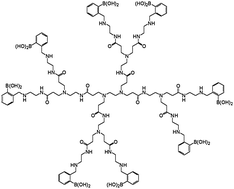Boronic aciddendrimerreceptor modified nanofibrillar cellulose membranes
Abstract

* Corresponding authors
a
Department of Chemistry, University of Bath, Claverton Down, UK
E-mail:
F.Marken@bath.ac.uk
b Unilever Research & Development Port Sunlight, Quarry Road, East Bebington, Wirral, UK
c School of Chemistry and Process and Environmental Research Division-Faculty of Engineering, University of Nottingham, University Park, Nottingham, UK
d Laboratory of Aquatic Chemistry, Department of Environmental Engineering, Technical University of Crete, Polytechnioupolis, Chania-Crete, Greece

 Please wait while we load your content...
Something went wrong. Try again?
Please wait while we load your content...
Something went wrong. Try again?
M. J. Bonné, E. Galbraith, T. D. James, M. J. Wasbrough, K. J. Edler, A. T. A. Jenkins, M. Helton, A. McKee, W. Thielemans, E. Psillakis and F. Marken, J. Mater. Chem., 2010, 20, 588 DOI: 10.1039/B918308F
To request permission to reproduce material from this article, please go to the Copyright Clearance Center request page.
If you are an author contributing to an RSC publication, you do not need to request permission provided correct acknowledgement is given.
If you are the author of this article, you do not need to request permission to reproduce figures and diagrams provided correct acknowledgement is given. If you want to reproduce the whole article in a third-party publication (excluding your thesis/dissertation for which permission is not required) please go to the Copyright Clearance Center request page.
Read more about how to correctly acknowledge RSC content.
 Fetching data from CrossRef.
Fetching data from CrossRef.
This may take some time to load.
Loading related content
